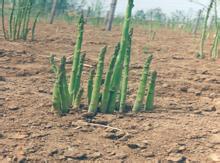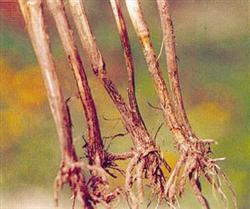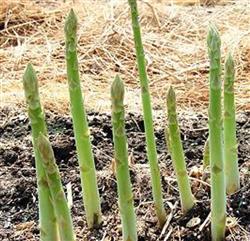Key points of raising seedlings of asparagus in spring

Asparagus production generally adopts seedling transplanting, and the seedling emergence rate of centralized seedling transplanting is high, which can save seeds, reduce costs, facilitate centralized management, help to control diseases and insect pests and cultivate strong seedlings, and can prolong the growth period of the planting year and increase the yield in the second year. Seedlings can be planted according to the growth direction of asparagus, which is convenient for ridge cultivation, asparagus collection and management. First, asparagus can be sowed in spring or autumn in cultivation season and sowing time. Spring sowing is generally sown from February to April, planted from April to June, and bamboo shoots are collected in the spring of the following year; autumn sowing from August to September, planting from October to November, and bamboo shoots can be picked in the next autumn. The sowing time can be pushed forward 6080 days from the planting date according to the stubble and seedling conditions. 2. the selection of seedling site and the preparation of seedling bed should choose loam or sandy loam with loose soil, fertile soil and good air permeability, which has watering and drainage conditions. the environment is open and ventilated because asparagus and onion and garlic vegetables are both lily crops, in order to reduce the occurrence of diseases and insect pests, the land where the previous crop is onion and garlic should not be used as a breeding or cultivation site for asparagus. 3. Seedling raising methods and seedling bed preparation mainly include raising seedlings in solar greenhouse, raising seedlings in plastic arch shed, raising seedlings in sunny beds and raising seedlings in open field. It is recommended to use nutrition bowl to raise seedlings, which has less root injury and high survival rate during transplanting. 1. Raising seedlings in solar greenhouse: the seedlings can be raised in a nutrition bowl, which should be ready before sowing. The diameter of the nutrition bowl is generally 8cm. The nutritious soil was prepared with 30% garden soil, 35% ring fertilizer, 30% peat soil, 1.5% compound fertilizer, 0.5% urea, 1% phosphate fertilizer and 20% potassium chloride, sifted and bowled and placed in the border. Before placement, use 4 kilograms of phoxim per mu of seedling bed and add appropriate amount of sandy soil to sprinkle it on the seedbed to prevent underground pests. Plastic film mulching and grass mulching increased temperature 10-15 days before sowing. 2. Raising seedlings in a small arch shed or sunny bed: the sunny bed can be made before winter, generally 1.5 meters wide and 10 to 15 meters long, and the north wall is 10 centimeters higher than the south wall. The seedlings can be raised in a nutrition bowl, and the preparation method of the nutrition bowl is the same as that in the solar greenhouse. The prepared nutrition bowl is placed in the sun bed or small arch shed. 3. Raising seedlings in open field: applying rotten compost 3000kg / mu, Sakefu compound fertilizer 50kg / mu, spreading evenly and ploughing 25cm, making the border after fine soil preparation, making a border with a width of 1.2m to 1.5m, leveling the border surface so that the soil is fine broken and the border surface is flat. The planting area of white asparagus and green asparagus are 60,70g / mu, 90g / mu, 90g / mu and 30g / mu, respectively, accounting for 20,30,30 square meters and 30,40 square meters respectively. Fourth, soaking seeds to promote germination asparagus seed coat is thick and hard, keratinization is strong, water absorption is difficult and germination is slow. in order to promote asparagus seed germination, asparagus seeds must be germinated before sowing. Before sowing, dry the seeds for 1 or 2 days, then bleach the blighted seeds and moth-eaten seeds with clean water, soak the seeds with 50% carbendazim 300x solution for 10 hours, soak the seeds in 30 ℃ ~ 35 ℃ warm water for 2 days, change water twice a day, wait for the seeds to absorb enough water, remove them in a basin, cover them with wet gauze or towels, or wrap them with wet gauze or towels, accelerate germination at a temperature of 25 ℃ ~ 30 ℃, rinse them with tap water 2 times a day. Sow seeds in time after germination. 5. before sowing and sowing, the nutrition bowl seedling bed or open field seedling bed is watered thoroughly, and a thin layer of soil is sprinkled after water osmosis, and the open field seedling bed is marked according to the row spacing of 10 cm, or cut the earthwork with a depth of 10 cm with a knife, take a germinated seed and sow it in the center of the square or nutrition bowl, cover the soil with 2 cm and 3 cm, and cover with plastic film after sowing. It can also be sowed or ditched in the open field. 6. Nursery bed management 1. Temperature: the suitable temperature for asparagus germination is 25 ℃ ~ 28 ℃. The temperature of raising seedlings in small arch shed or sunny border should be controlled at 25 ℃ ~ 28 ℃ in daytime and 15 ℃ ~ 18 ℃ at night. After emergence, 25 ℃ during the day, the lowest temperature is not less than 8 ℃, the highest temperature is not more than 30 ℃, and more than 30 ℃ should be released in time. And gradually increase ventilation to make it adapt to the external natural environment. When the seedling has more than 3 aboveground stems, it can be planted. 2. Water and fertilizer: the soil of the seedling bed should be kept moist before emergence, otherwise it should be watered in time, and the root system of the seedling should be weak after emergence and watered in time in case of drought. When the seedling height is about 10 cm, a thin organic liquid fertilizer can be applied with water, such as fully mature human feces, urine or biogas liquid, urea and potassium chloride can also be applied with water, and topdressing at seedling stage for 2 to 3 times, so that seedlings can fully accumulate assimilation nutrients in the late growth stage to cultivate strong seedlings. 3. Ploughing and weeding: remove the plastic film immediately after emergence. After sowing, the seedlings should be thinned and the distance between seedlings should be kept at 7 cm to 10 cm. Weeding should be done frequently during the seedling raising period, and the soil should be ploughed and loosened in time. Properly cultivate the soil to make the scale buds develop sturdily and prevent the seedlings from lodging. When the seedlings reach the standard of planting seedlings, they can be planted. The planting standard is that the height of the seedling is about 0.3 meters, there are more than 3 aboveground stems and more than 5 underground stored roots.
- Prev

Causes and control of a large number of dead plants of asparagus
The reasons for asparagus death are as follows: 1. Asparagus likes light. From September to October 2007, when the aboveground parts of asparagus grew vigorously and accumulated nutrients, laying the foundation for the next year's high yield, we suddenly encountered the continuous overcast and rainy weather that we had not seen for many years, resulting in a serious lack of light, resulting in stagnation of asparagus growth, decrease of nutrition accumulation and stress resistance.
- Next

Asparagus pest control 14 points negative mud insect
It is widely distributed in China. It occurs 3-4 generations a year in Shandong and other places. It causes damage by eating young stems or epidermis of asparagus as adults and larvae. It can lead to abnormal shoot plants or eat them into bare ones, resulting in short and abnormal shoot plants or branches, pseudo-leaves clustering, serious dryness and death. The winter season is the season of winter...
Related
- Where is it suitable to grow horseradish in China? it is expected to see the middle altitude horseradish in Alishan.
- How to prevent tomato virus disease reasonably? (Control methods included)
- Many people like to plant towel gourd on the balcony. What are the main points of this method and management?
- What crops can chili peppers be mixed with?
- Fertilization techniques and matters needing attention in Tomato
- What are the grafting techniques for peach seedlings in spring?
- Harm and control methods of root swelling disease of Chinese cabbage
- What are the pests of sweet potatoes? How to prevent and cure it?
- Symptoms, causes and Control methods of navel Rot in Tomato
- The cause of "Cucumber rotten bibcock" in Farmers' planting Cucumber and its Control Plan

